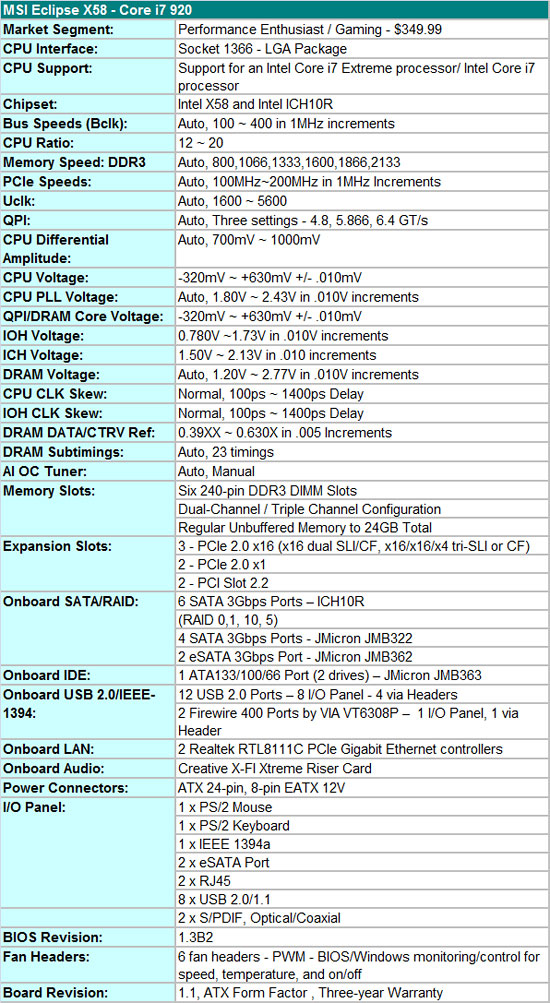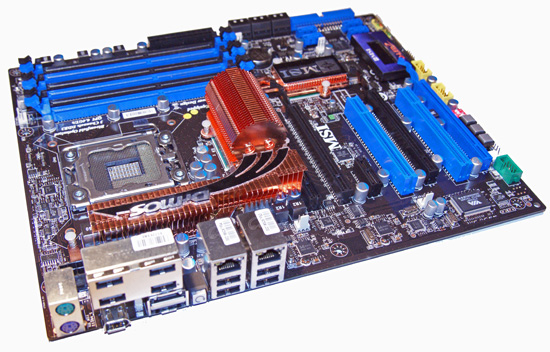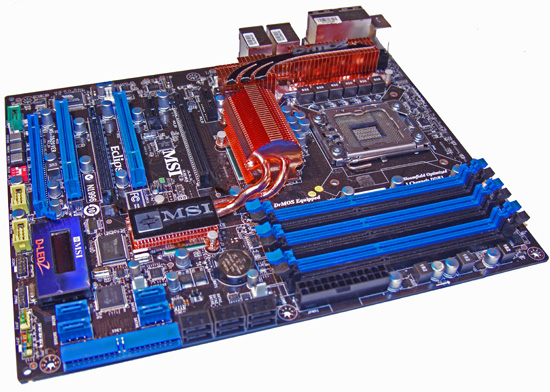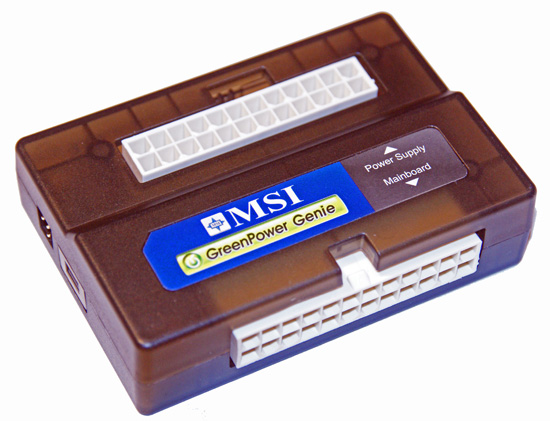Intel X58 Motherboard Roundup - What does $300 Get You?
by Gary Key on December 5, 2008 3:00 PM EST- Posted in
- Motherboards
MSI Eclipse X58
Features

The MSI Eclipse X58 is a feature laden board from a hardware and software viewpoint. It should be considering the $350 price tag, although there is a $30 mail-in-rebate at present. The almost universal Realtek RTL-8111C PCIe Gigabit Ethernet controllers are utilized in tandem; a riser card featuring the Creative Lab's CA0110-IBG chipset provides HD audio and EAX 5.0 capabilities; JMicron’s JMB 363/362/322 chipsets are tabbed for eSATA, IDE, and additional SATA port duties; VIA's VT6308P provides IEEE 1394a support; and the Intel ICH10R is utilized for primary storage purposes.
The BIOS is designed for overclocking duties, although it's not as comprehensive as those from ASUS or Gigabyte. However, it is fair to say that several of the options that ASUS and Gigabyte provide will never be touched by about 95% of us when overclocking. Our main knock against the BIOS is that it is not as user friendly as the others in this roundup. We do not care for the +/- voltage settings as it becomes confusing for the user to understand exactly what effect their changes had on the particular option, especially without knowing what the base voltage is set at.
MSI supports stock memory speeds up to 2133MHz on the i920/i940 processors along with opening up QPI link speeds from a standard 4.800 GT/s up to 6.400 GT/s, which is standard on the i965 Extreme processor. The board fully supports 24GB of DDR3 memory. We have a 24GB kit arriving shortly for testing so we cannot confirm compatibility yet, but we trust MSI in this regard.
In the meantime, we have not had any problems running 12GB with our Patriot or G.Skill DDR3-1600 kits up to 1600 at 9-8-8-24 1T timings, although we needed about 1.68V for absolute stability with the i920 at stock speeds. Dropping the command rate to 2T allows 1.64V operation with the current BIOS. Overall, memory performance is very competitive with the other boards and improving in each BIOS release. However, this is the only six slot board that we have been unable to clock a 12GB configuration up to a 191x21 setting. The board stops around a 175 Bclk with an 8x memory multiplier that results in a DDR3-1528 speed. The board will clock up to a 191 Bclk with the memory multiplier at 6x, which results in a DDR3-1146 setting. MSI is working on improving this area.
The Eclipse board contains three PCI Express 2.0 x16 slots that operate in x16/x16 mode for 2x SLI/CF. The third x16 slot operates in x4 mode regardless of the second slot population. 3x SLI/CF configurations run in x16/x8/x8 mode on the EVGA and Gigabyte boards. We did not notice any performance differences between the x16/x16 or x16/x8 operation in 2x CF with our HD 4870 cards. However, we just received a new BIOS from MSI that allows 3X SLI/CF to operate properly. We will update the article in a few days with a comparison between the boards utilizing all three x16 slots. We had no problems running our ASUS Xonar D2X or Highpoint Rocket RAID cards in slots two or three.
The Board


The Eclipse X58 is MSI's current flagship board with the recently introduced Platinum X58 filling a void in the low end X58 market with a $220 price tag. While $220 is an awful lot for a motherboard, it's practically a bargain in this particular market sector. Of course, you give up a few items like SLI compatibility, an additional x16 slot, and the JMicron SATA ports, but for a lot of users those features are not that important.
MSI went a different direction with this board compared to earlier designs; gone is the roller coaster or circular heatpipe design, as is the traditional fire engine red color scheme that is now a subdued black and blue color palette. While colors do not determine the performance of a board, they do tend to make a difference in first impressions. We like the new color scheme and sincerely appreciate a more traditional heat pipe setup. In fact, MSI skipped on an elaborate heatpipe setup found on other boards and concentrated on cooling the voltage circuitry separately, although the northbridge and southbridge are still linked together.
The CPU area is fairly open and our larger air coolers did not pose a problem. The Eclipse board features a two-phase power delivery system for the northbridge and for the memory subsystem. A six-phase power delivery design is utilized for the processor, half that of the Gigabyte and ASUS boards. However, this did not adversely affect the overclocking capabilities of the board. MSI utilizes high quality solid-state capacitors and ferrite core chokes on the board.
The general layout is very good as MSI has managed to situate the vast number of ports, slots, and hardware in a manner that keeps them from interfering with installed peripherals. MSI managed to squeeze three PCI Express 2.0 x16 slots (x16/x16/x4), two PCIe x1 slots, and two PCI slots. This arrangement allows 3X Crossfire or SLI and still leaves a single PCIe x1 slot open. However, using a double slot card in the third slot will make it extremely difficult to utilize the power, reset, IEEE 1394a, and USB ports. Our opinion about 3X CF/SLI is not that high unless you are benchmarking for 3DMark records, so we appreciate the fact that a 2X CF/SLI arrangement will leave a PCIe x1, PCI, and PCIe x16 (x4 electrical) slot open.
On the bottom of the board you will find onboard buttons for power, reset, and the D-LED 2 display module. The D-LED 2 is handy for a quick glance during the POST process or you can have it display VCore or northbridge voltages along with pinpointing a particular temperature on the board with the included 20" probe. The D-LED does not display hex codes, instead relying on short hand messages like "DDR Ini" during post processes.
While we appreciate the D-LED, it is really only good for windowed cases or open platform testing. We think MSI should have included an attachment cable that allowed placement outside of the case. Also, the unit does not live up to its potential by providing additional hardware monitoring capabilities such as temperatures, fan speeds, or other voltage readings. Of course, MSI has monitoring software that accomplishes these tasks, but we think a hardware solution would be better, especially considering the cost of the board.
The IO panel features eight USB 2.0 ports, two Ethernet jacks, an IEEE 1394a port, and two eSATA ports courtesy of the JMB 362 chipset. MSI also includes an expansion slot backplate that allows an additional two eSATA ports via any of the board's internal SATA connections. An audio output panel is missing since MSI utilizes a riser card that features Creative Lab's CA0110-IBG audio chipset.
Our first reaction was very positive until we looked at the chipset specifications and realized that hardware audio processing capabilities - including the EAX 5.0 implementation - are done through software and the CPU. Also, most of the software features from a standalone X-FI card are not available in the software package that MSI provides. They did include access to Creative's 24-bit Crystalizer and speaker virtualization features along with other hardware settings.
Of course the big question is the audio quality provided by this solution. RightMark Audio Analyzer indicated poor THD and inter-channel leakage, but in actual usage we could not tell any real differences between the Creative and Realtek solutions in music playback quality. The ADI solution on the ASUS board sounded a bit clearer and dynamic in music playback. In gaming, we thought the Creative solution was slightly better than the ADI chipset and noticeably better than the Realtek solutions on the Gigabyte and EVGA boards. If gaming or music playback is a priority, we still suggest an add-in card for best performance.
The Application


MSI features a unique power saving system on the Eclipse. They include a GreenPower Genie pass-through connector that attaches to the 24-pin ATX power supply cable and a cable that attaches to the 24-pin ATX connector on the motherboard. There is also a two-pin cable that attaches to the Genie and the motherboard that works in conjunction with the the GreenPower software to monitor and dynamically reduce power usage.
This system will automatically scale the number of active power phases for the processor, memory, and northbridge. We noticed savings of 9W at idle, so it actually works. In fact, it provides better results than the ASUS EPU-6 or Gigabyte DES power saving systems. During testing, it was able to switch fast enough so we did not have to worry about program crashes when utilizing GreenPower. The one drawback is that the pass-through connector and cable is a bit cumbersome to use in smaller cases.
















78 Comments
View All Comments
TantrumusMaximus - Monday, December 8, 2008 - link
THANK YOU THANK YOU ANAND.I haven't had a chance to read the entire article but did read all of Anand's comments and am floored. Good Job keep it up and we readers appreciate it. It's gone out of control, prices through the roof for mobos and QA is through the floor. The comments of "why would you want 12GB?" coming from the Manuf mouth is just unsettling at best... if I choose to populate 6 DIMM slots that better work, they're there, and I expect em to work not to be asked WHY I want 12GB!!!!
CarlosMC - Monday, December 8, 2008 - link
You just saved me over 1000€ on a new system - guess I'll stick to my 939 for the time being and if things won't change, maybe I'll find better things to do with my money and, specially, my time.DaveLessnau - Monday, December 8, 2008 - link
And, while talking about the basic quality of the board and the company behind it, don't forget to talk about the manufacturer's web site. Specifically, does it have a forum where people can talk about the individual boards? How slow is the site, itself? Can you actually download things at reasonable speeds? Also, how's the English on the site and also in the documentation (to internationalize that a bit, for any localized site that the company maintains, is the local language real or does it read like something run through Google Translate?)?Emperor88 - Monday, December 8, 2008 - link
"Hey guys, Anand here. I'm writing this sub-section, not at Gary's request, but because I felt it was necessary."I was really pleased to read that section. Not because of the problems experienced, which is terrible and motherboard makers really need to pull their heads in, but because of the honesty shown. More of that kind of commentary would be great, thanks :)
I think you should add the problems you experience in getting things working correctly in every article. Even briefly would be better than nothing as it paints a deceptive picture of the product's abilities if left off as all the amazing performance figures are presented without acknowledging the hours of fiddling required (by professionals no less!) to get the products up to scratch.
Zak - Monday, December 8, 2008 - link
I would be happy to get a mobo that has the basics and no on-board sound, NIC and RAID controllers. These devices often fail and can't be replaced. I'd rather opt for a plain but fast and stable $100 mobo with twice the number of PCI-e slots so I can pick my own devices. Oh, and no legacy stuff: serial, parallel, floppy controller. But I wonder how many reviewers would give it low ratings because it's not overloaded with features?Z.
strikeback03 - Monday, December 8, 2008 - link
Would need a new motherboard/case standard, obviously ATX couldn't accommodate twice the PCI-E slots. And this will probably never happen, as they seem to not be able to decide when to phase out support for legacy standards such as PCI and floppy. I can't wait to see IDE go, and Intel was onboard with that plan several chipsets ago, put pretty much everyone still includes IDE connectors.Rindis - Wednesday, December 10, 2008 - link
How do you figure? Most motherboards just have ~3 PCI-E slots + PCI. Remove PCI and you have plenty of room for the expanded PCI-E handling.I'll admit I've still got a lot of legacy devices with life in them, so I'm not so keen on abandoning it all. But, as long as it's not a case of abandoning legacy on every motherboard immediately, I think it's past time we see some pure PCI-E + SATA + USB boards.
I'll also agree with two posts above. My preferred motherboard configuration is no video, no sound, no network. Okay, network controllers are at the point where I use the on-board ones now; but I know of good, reliable, well-priced cards that beat whatever will be on the board, and I don't want to pay for the features I won't be using, and I don't want to have to worry about smashing them into submission. (Which is also better today, but I remember all too well the headaches of turning early on-board audio off.)
michal1980 - Sunday, December 7, 2008 - link
This whole motherboard hell is one reason, I didn't even consider upgrading my pc in the past 2 years (that and a quad intel @3ghz is plenty for just about anything right now)Ever time I upgraded I went through 2-3 motherboards because ethier they were broken out of the box, or had issues with some other piece of hardware. And its everyone, i've had issues, with evga, gigabyte, asus, abit, etc etc.
What I really couldnt understand, is most times, I spent the extra money to get the mobo that got good reviews from sites like Anand.
So while I'm glad your finally going after Mobo manufactures, I feel that you guys bare some of the responsiblity because you allowed it to happen.
To all readers, just how bad must it be that Anand is finally. FINALLY speaking out? If his speaking out, the boards must be total CRAP. Just plain junk, not only that, 300 dollar junk.
Part of the problem IMHO, is all this built in stuff, its nice, but it causes corners to be cut, built in network cards, heck, lets make it 2, built in sound cards, etc etc. I'm not even sorry, after a new mobo comes out, i'm waiting 6+ months before i'm even going to consider buying one. I'm sick of being the QA for these manufacture
SixOfSeven - Sunday, December 7, 2008 - link
In the discussion of the ASUS P6T, you state "The board officially supports 12GB of DDR3 memory, although we expect full support for 24GB in a future BIOS release." Can you share the basis for this claim? In particular, does ASUS guarantee that P6Ts purchased now will eventually be able to support 24GB with some later BIOS upgrade?CEO Ballmer - Sunday, December 7, 2008 - link
Intell is on the ball!http://fakesteveballmer.blogspot.com">http://fakesteveballmer.blogspot.com